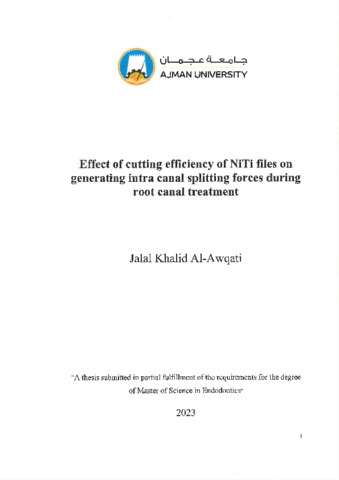An in-virto Comparative Study of the Antimicrobial Activity of Freshly Mixed Root Canal Sealers Against Four Types of Microorganisms Using Two Assessment Methods
Abstract
Purpose: To compare the antimicrobial effect of four freshly mixed root canal sealers (pulp canal sealer, Sealapex, AH Plus and MTA Fillapex) against four types of microorganisms. (Enterococus faecalis, Escherichia coli, Staphylococcus aureus) and one type of yeast (Candida albicans) using Agar diffusion test (ADT) and Direct contact test (DCT).
Materials and methods: The microorganisms used in the present study consisted of Enterococus faecalis, Escherichia coli, Staphylococcus aureus and Candida albicans (Isolated strains). Agar diffusion Test (ADT) and Direct Contact Test (DCT) were used to evaluate the antimicrobial activity of the experimental sealers. In the ADT, freshly mixed sealers were poured into uniform wells punched in the agar. After 24 h incubation, the diameter of the formed inhibition zones were observed and measured in mm. The results were collected and statistically evaluated using parametric tests. In DCT, A 10 ml suspension of each microbial strain was placed directly on the test material 20 minutes after mixing and allowed to directly contact the sealers for 1 h at 37C. Bacterial growth was then spectrophotometrically measured every 30 min for 7 h. the optical density of the bacterial growth was recorded at each time interval.
Results: Agar diffusion test results: The results indicated that all sealers had antimicrobial effect and with significant difference between them. Pulp Canal Sealer had the highest significant antimicrobial effect against all microbial strains except E. facealis to which Sealapex had the highest antimicrobial effect. There is no significant difference between the antimicrobial effect of AH Plus and MTA Fillapex against E.coli, S. aureus and C. albicans. Direct contact test results: Pulp Canal Sealer had the highest significant antimicrobial effect against all microbial strains. However, there was no statistically significant difference between Pulp Canal sealer and Sealapex regarding the antibacterial activity against E. faecalis, E. coli and C. albicans. Regarding AH Plus and MTA Fillapex, there was no statistically significant difference between their antimicrobial effect against E. faecalis, E. coli and S. aureus. MTA Fillapex had the lowest antimicrobial effect against C. albicans.
Conclusion: All selected sealers had antimicrobial effect against all experimental microbial strains. All the sealers were distinctly different from each other in their antimicrobial activity. The sealers showed different inhibitory effects depending on the types of microbial strains and the assessment method. Pulp canal sealer containing eugenol proved to be the most effective against most of microorganisms. Sealapex had a strong antimicrobial effect against E. faecalis. AH plus and MTA Fillapex had the same antimicrobial effect against most microbial strains.
Keywords: Antimicrobial effect, Root canal sealers, Enterococus faecalis, Candida albicans, Direct contact test, Agar diffusion test.

